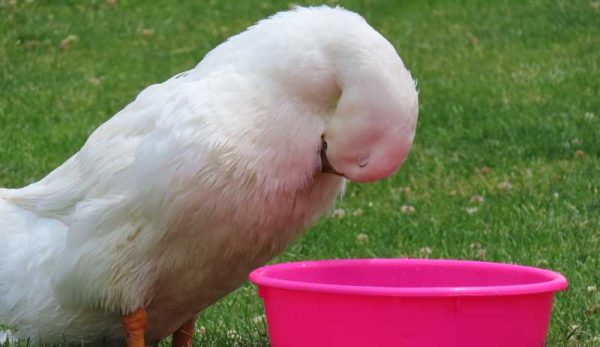
As members of the waterfowl family, ducks naturally thrive in water. Choosing the correct water source for your ducks, then, is crucial for their health and well-being. Before selecting the proper water source, let’s examine why water is so essential for ducks.
Like all livestock, ducks need access to fresh drinking water daily. But they also need the water to keep themselves clean. While many poultry-keepers provide water fountains for chickens, a fountain makes an inadequate water source for ducks. Poultry water fountains do not give ducks enough water to keep themselves clean, resulting in eye infections, difficulty breathing due to clogged nares (more on that later) and poor feather quality.
When choosing water sources for your ducks, there are many options, from ponds to stock tanks and even kiddie pools. Let’s look at the pros and cons of each of these options.
Water Buckets

It may sound odd, but ducks submerge their heads to clean out their eyes and nares (nostrils). This unusual trait helps them clean their eyes to avoid eye infections. Two-gallon water buckets are the perfect source for your ducks to do just that.
Ducks can often be seen dunking their heads up and down in a bucket or kiddie pool sneezing. When a duck sneezes with its head submerged, the water helps to flush out any dirt, feathers or other debris that might have gotten caught. While this bathing ritual may seem silly, it is the only way ducks can adequately clean their nares to support a healthy respiratory tract.
A water bucket is the perfect everyday water source for ducks to clean their eyes and noses. However, if you want to keep ducks with good feather quality, providing them with a pool or access to a pond several times a week is crucial.
Ponds
Although many duck owners consider a pond the ideal water source, from personal experience, it’s hard to find positives to letting your ducks loose on a pond. But before we get into the cons, let’s first look at the pros of providing a pond for your ducks.
Pros
A pond is a natural setting. Allowing ducks to lead a natural life, as close as possible to their wild cousins, sounds very appealing to many flock owners.
No Water Changes
With a pond, you never need to worry about emptying and refilling it. This isn’t the case with a stock pond or kiddie pool.
No Need to Feed
Many duck owners enjoy the free feed bill that a pond provides. However, if you want your ducks to return to the barn at night or wish to collect eggs from them, feeding them is a must.
Cons
Snapping Turtles
Snapping turtles frequent most ponds and are one of the duck’s biggest predatorial threats. These mean-spirited reptiles are hard to spot and often live close to humans without being seen. Protect your flock and avoid the pond.
Bringing Ducks Home
If you want your ducks to return to the barn at night or wish to collect eggs from them, removing the ducks from the pond becomes an every-evening ritual. Ducks generally don’t come when called and can be stubborn about leaving the pond. Bringing the ducks home will require jumping in a row boat and herding the ducks off the pond.
Wild Waterfowl
Allowing domestic ducks on a pond where wild waterfowl frequent is a common mistake. This practice can spread diseases from the wild ducks and geese to your flock. These diseases include (but are not limited to) avian influenza, E. coli and internal parasites.
Kiddie Pools
Pros
Ideal for the Suburbs
A kiddie pool’s small size is perfect for a couple of ducks in the backyard. For this reason, this is often the first choice for pet duck owners.
Predator Protection
If going the extra mile to keep your flock safe from predators is at the top of your priority list, then a kiddie pool may be your best option. Kiddie pools fit into most enclosed runs or chicken tractors easily.
Cons
Frequent Changes
Emptying water from the pool with a bucket daily and refilling it is considered a con by most flock owners’ standards.
Made from Cheap Plastic
While kiddie pools are budget-friendly, they may not always be the best choice. The flimsy plastic cracks easily and could result in a need to buy pools frequently. Also, kiddie pools are only available to purchase for a few months of the year.
Flexible Plastic Stock Tank
Pros
They Just Work
A stock tank is sturdy, comes in various sizes and should easily fit into most runs or enclosures. Stock tanks are also less likely to freeze in winter due to the black tank absorbing sunlight and warming the water temperature above freezing.
Cons
Lots of Water
Stock tanks hold more water than a kiddie pool or bucket. Because of this, they will take longer to empty and refill daily.
Require More Room
Stock tanks are usually taller than a kiddie pool. You may need to get a ramp for your ducks to access the swimming area.
Flexible Plastic Mixing Tub
Pros
Ideal Size
Our Tuff Stuff mixing tub has worked the best of all the water sources we have tried for our ducks. This tub is an ideal size to fit into most runs and enclosures comfortably. It also is the easiest for our ducks (including our 10-year-old arthritic Pekin) to climb in and out of.
Cons
Like kiddie pools and stock tanks, mixing tubs require daily emptying with a bucket and refilling with fresh water. This prevents bacteria from growing and causing illness in the flock.
Providing one or more water sources is essential for happy, healthy ducks. An alternate water source from the traditional pond allows many backyard enthusiasts to enjoy ducks while providing swimming water and endless hours of enjoyment for you and your flock.





